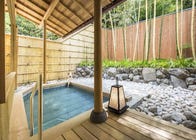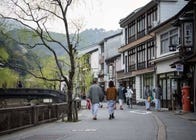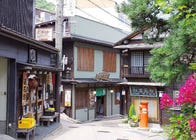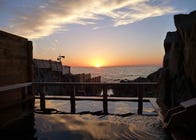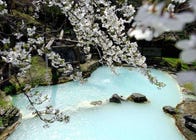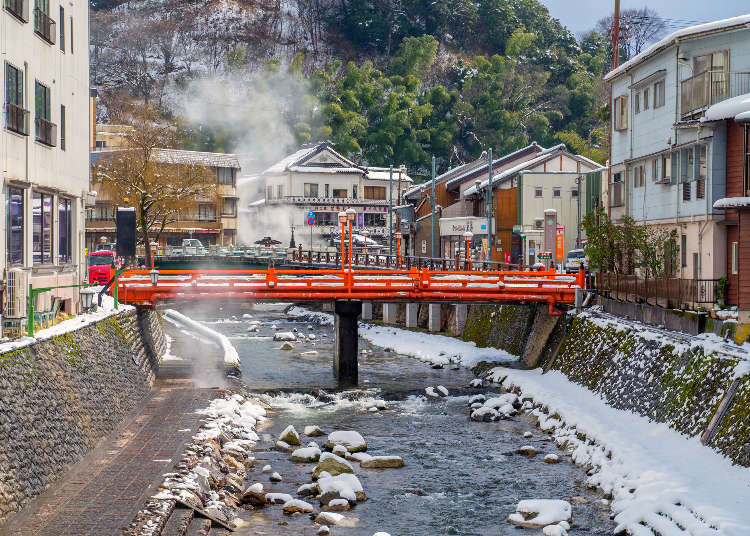
10 Popular Hot Springs Resorts Near Kyoto and Osaka
- Written by: WESTPLAN
Hot springs are a popular destination for visitors to Japan. And the midwestern region of Kansai, home to tourist hot spots such as Osaka and Kyoto, is full of them!
There are many excellent hot springs in Kansai, each with its own unique features, qualities, and locations. Here are some of the most popular springs where you can get a taste of history, and unwind from a long day of sightseeing with a long, relaxing soak.
Top image: PIXTA
- Table of Contents
-
- 1. Yuhigaura Onsen (Kyoto Prefecture)
- 2. Arashiyama Onsen (Kyoto Prefecture)
- 3. Totsukawa Onsen (Nara Prefecture)
- 4. Dorogawa Onsen (Nara Prefecture)
- 5. Kinosaki Onsen (Hyogo Prefecture)
- 6. Arima Onsen (Hyogo Prefecture)
- 7. Yumura Hot Spring (Hyogo Prefecture)
- 8. Shirahama Onsen (Wakayama Prefecture)
- 9. Nanki Katsuura Onsen (Wakayama Prefecture)
- 10. Ryujin Onsen (Wakayama Prefecture)
1. Yuhigaura Onsen (Kyoto Prefecture)
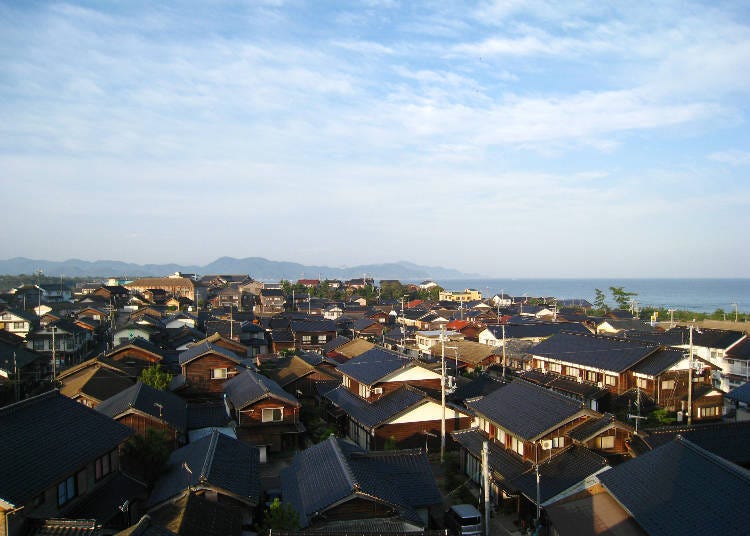
Yuhigaura Onsen (夕日ヶ浦温泉) is a hot spring located in Kyotango City in the northern part of Kyoto Prefecture. Excavated in 1980, this high-temperature hot spring is of a hypotonic, weakly alkaline quality and is also known for its skin-beautifying effects.
There’s also a stunning, sandy white beach right before your eyes, stretching out about 8km in length. The seaside accommodation facilities along the beach also boast amazing, up-close views at sunset!
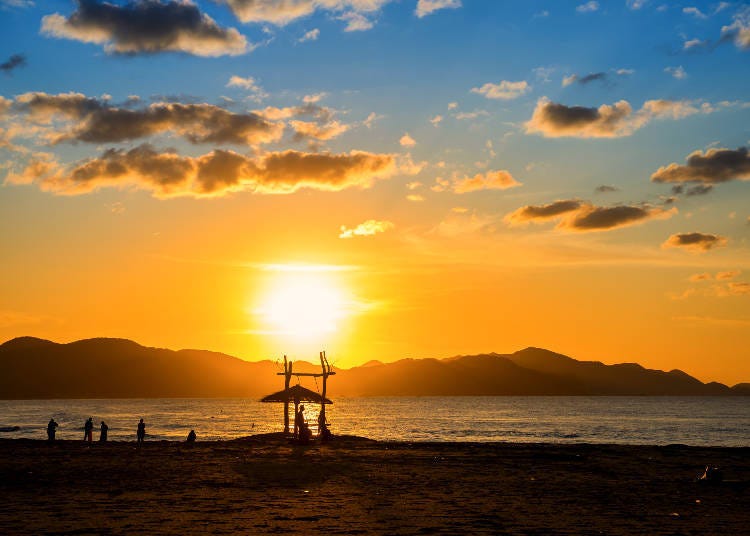
Yuhigaura is one of Tango’s most famous places for watching the sunset, having even been recognized as one of Japan’s 100 Best Sunset Spots (by the NPO Association of Township Building Sunrise and Sunset in Japanese Islands). The reflection of the setting sun, brilliantly glittering on the ocean’s surface, is a spectacular sight that you won’t want to take your eyes off!
- Tips on visiting:
- Yuhigaura Onsen is a scenic hot spring, famous for its beautiful sunset views. In the summer, check out some fun seaside activities at Yuhigaura Beach!
- About the hot springs:
- Yuhigaura is right near the beach, with about 30 accommodation facilities and hotels. Some have open-air baths, and others boast beautiful ocean views, right from your room!
- Getting there:
- Yuhigaura-Kizu Onsen Station is about 3 hours away from JR Osaka Station via the Kounotori Limited Express train.
- Hot spring qualities & benefits:
- These springs are hypotonic, weakly alkaline, and high-temperature, and are said to be effective in relieving fatigue, neuralgia, and rheumatic diseases, as well as beautifying the skin.
- Popular places to stay:
- Kaikatei Hanagozen, Kaikatei Shihokaku, Kaishu, Kashoen
2. Arashiyama Onsen (Kyoto Prefecture)
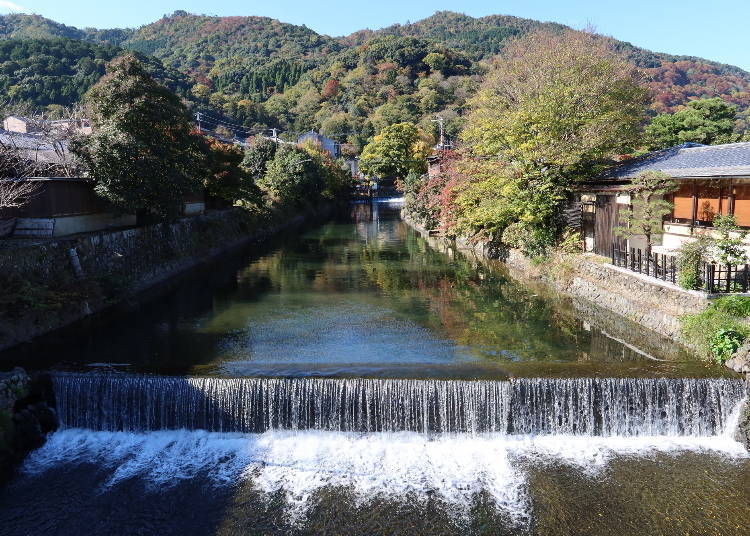
Arashiyama is another popular tourist destination. It has served as a vacation spot for aristocrats for a very long time.
Excavation of Arashiyama Onsen (嵐山温泉) began in 2003, and opened in 2004. The springs are hypotonic and weakly alkaline. The surrounding area is dotted with traditional inns with both private open-air baths and open-air baths with a panoramic view of Arashiyama. You’ll also find hot spring facilities that offer day-trip bathing.

At Randen Arashiyama Station, there’s also a hot spring facility on the platform called Arashiyama Onsen Eki no Ashiyu. Admission is 200 yen per person, and incudes an original towel.
- Tips on visiting:
- Arashiyama is one of Kyoto’s signature tourist attractions, with landmarks such as Togetsukyo Bridge, hot springs, and gorgeous seasonal scenery, all year round!
- About the hot springs:
- The scale of the hot springs is small, with about five accommodation facilities that source their water from the springs. As a tourist hot-spot, there are many accommodations with unique features.
- Getting there:
- From Hankyu Osaka-Umeda Station, take the Kyoto Line via Katsura Station to Randen Arashiyama Station (approx. 47 min)
- Popular places to stay:
- Kyoto Arashiyama Onsen Kadensho, Arashiyama Onsen Saishiki no Yado Hanakada, Kyoto Arashiyama Onsen Togetsutei
-

-
Address
Nishikyoku Arashiyama Nishiichikawacho 5-4, Kyoto, Kyoto, 616-0003
View Map -
Nearest Station
Arashiyama Station (Hankyu Arashiyama Line)
4 minutes on foot
Vacancy search, reservation
-
from 21,580JPY 1room, 2adults
Check with our partner site as the latest rates, rate details, and guest room requirements may vary.
-
Address
Nishikyoku Arashiyama Nishiichikawacho 5-4, Kyoto, Kyoto, 616-0003
3. Totsukawa Onsen (Nara Prefecture)
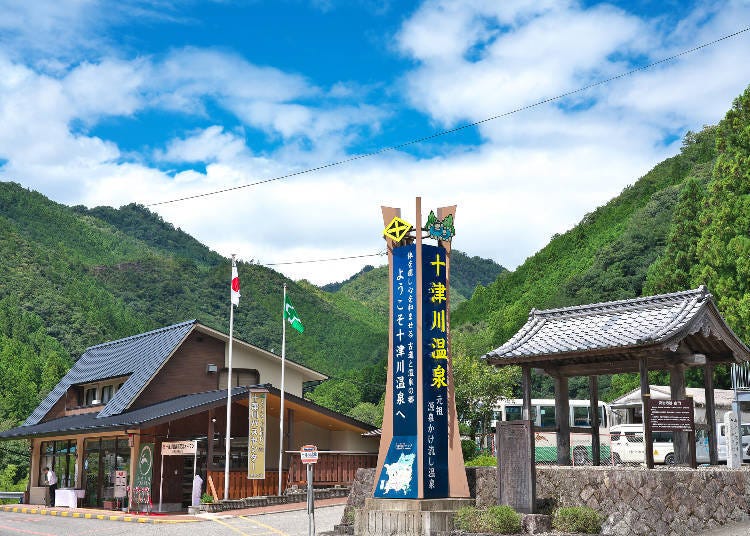
Totsukawa Village, located in Nara Prefecture’s Yoshino District, is the largest village in Japan. Totsukawa Onsen (十津川温泉) is located on the shores of Lake Futatsuno, and is the town’s most popular hot spring. The water is sourced from a spring that was discovered during the Genroku Period (1688-1704).

There’s a variety of other springs in the area, including Tosenji Onsen in central Totsukawa Village, and Kamiyu Onsen, located upstream of the Kamiyu River.
Many areas around Totsukawa Village are inaccessible by train, so we recommend traveling by bus or car. You can take the bus bound for Onsenchi Onsen (in front of Totsukawa Village Hall) from the Kintetsu Limited Express Yagi Station. There are also local buses that run throughout the village.
By car, it’ll take about three hours if driving from Osaka. From Onsenchi Onsen to Totsukawa Onsen, it’s about 20 minutes by car. It’s also about 20 minutes from Totsukawa Onsen to Kamiyu Onsen.
You can also get to the famous Tanize Suspension Bridge in Totsukawa Village from Onsenchi Onsen (about 35 min by car). This gigantic suspension bridge stands at 54 meters and stretches about 297 meters long!
- Tips on visiting:
- In 2004, this village was the first in the country to declare itself one in which every hot spring facility in town offers free-flowing springs.
- About the hot springs:
- Totsukawa Onsen alone boasts 10 hot spring inns, with a total of 17 hot spring inns in the area sourcing their waters from three different springs. Totsukawa Onsen and Onsenji Onsen also have village-run public bathhouses that are also worth checking out!
- Getting there:
- From Kintetsu Osaka Namba Station, take the Kintetsu Limited Express to Yagi Station. From there, take the Nara Kotsu Bus to Onsenchi Onsen (Totsukawa Village Hall) (approx. 3 hrs)
- Hot spring qualities & benefits:
- Totsukawa Onsen is a sodium bicarbonate/chloride spring. It contains salt and keeps you warm long after your bath. It’s even said to be effective for cuts and burns. The simple sulfur springs are also beneficial for gynecological diseases. Kamiyu Onsen is a sulfur-containing sodium bicarbonate spring with moisturizing effects for the skin.
4. Dorogawa Onsen (Nara Prefecture)
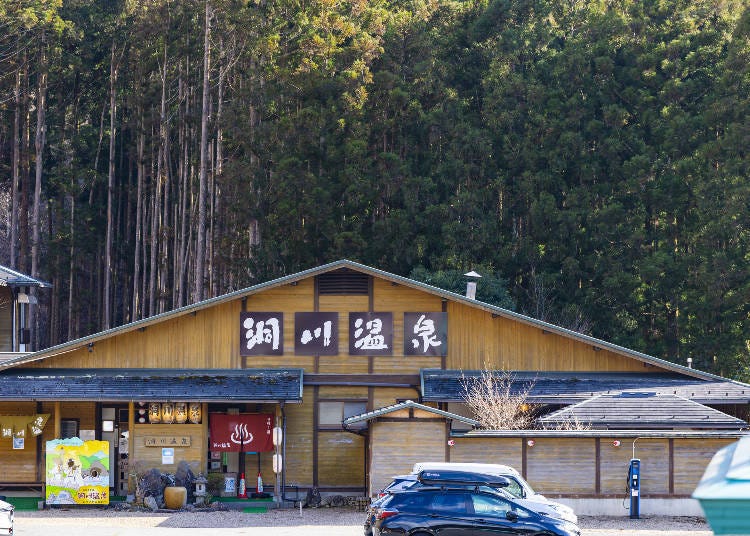
Tenkawa Village is located in Yoshino in Nara Prefecture. About a quarter of the area is designated as Yoshino-Kumano National Park, which offers magnificent natural landscapes all year round.
Dorogawa Onsen (洞川温泉) is located at the starting point of Mt. Omine, a World Heritage Site. Situated in a mountain village at an altitude of over 800m, this hot spring resort is also nicknamed the ‘Karuizawa of Kansai’ for its cool and comfortable climate.
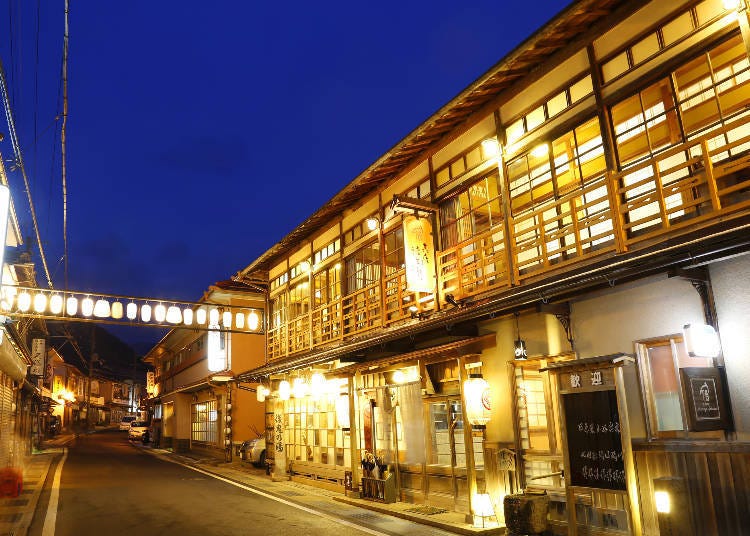
Dorogawa Onsen Town maintains an old-fashioned, retro atmosphere with rows of wooden buildings, such as ryokan (traditional Japanese inns), inns, and souvenir shops.
- Tips on visiting:
- These springs are located in the middle of nature, surrounded by mountains. Mt. Omine is a hot spring town with a history as a pilgrimage stop, and a peaceful, mountain atmosphere to match.
- About the hot springs:
- There are around 20 hot spring inns and guesthouses in the area that offer not only bathing, but delicious, local cuisine. There’s also the village-run Dorogawa Onsen Center, located at the entrance to Dorogawa Onsen.
- Hot spring qualities & benefits:
- These simple springs are weakly alkaline, and said to be beneficial for neuralgia, muscle pain, arthralgia, and cold sensitivity.
- Getting there:
- From Kintetsu Osaka Abenobashi Station, take the Kintetsu Limited Express to Shimoichiguchi Station, then take the bus to Dorogawa Onsen (approx. 2 hr 30 min).
-
Atarashiya Ryokanあたらしや旅館
- Address Tenkawamura Dorogawa 215 , Tenkawa, Nara, 638-0431
-
Nearest Station
Yoshino Station (Kintetsu-yoshino Line)
5. Kinosaki Onsen (Hyogo Prefecture)

Kinosaki is located in the northern part of Hyogo Prefecture and faces the Sea of Japan. It is also one of the leading hot spring towns in the Kansai Region.
In 2020, Kinosaki Onsen (城崎温泉) celebrated a history of nearly 1,300 years. It is said to have first sprung up around the year 720 after 1,000 days of prayer by the Buddhist monk, Dochi Shonin. A stone arch bridge stretches across the Otani River, lined with beautiful willow trees and long-established Japanese inns. The landscape is truly befitting of the birthplace of a Japanese hot spring!

There are seven hot springs of varying styles within a 20-minute walking distance. Another one of Kinosaki Onsen’s attractions is that you can wear a yukata and take a tour of the springs.
- Tips on visiting:
- Kinosaki Onsen is popular with domestic and international tourists alike. Souvenir shops line the banks of the Otani River, and there are many sightseeing attractions in the surrounding areas.
- About the hot springs:
- There are about 70 inns and hotels in the area, and about seven public baths within a 20-minute walking distance.
- Hot spring qualities & benefits:
- These sodium-calcium chloride, high-temperature springs are said to be beneficial for neuralgia, muscle pain, and digestive disorders.
- Getting there:
- From Osaka Station, take JR Limited Express Kounotori line to Kinosaki Onsen Station (Approx. 2 hr 30 min)
- Popular places to stay:
- Nishimuraya Hotel Shogetsutei, Tokiwa Annex, Fugetsu Gyosho, Tsutaya Seirantei
-

-
Address
1016-2 Kinosakicho Yushima, Toyo oka-shi, Hyogo, 669-6101
View Map -
Nearest Station
Kinosakionsen Station (JR San-in Line)
26 minutes on foot
Vacancy search, reservation
-
from 79,585JPY 1room, 2adults
Check with our partner site as the latest rates, rate details, and guest room requirements may vary.
-
Address
1016-2 Kinosakicho Yushima, Toyo oka-shi, Hyogo, 669-6101
-

-
Address
1013, Kinosakichoyushima, Toyooka-shi, Hyogo, 669-6101
View Map -
Nearest Station
Kinosakionsen Station (JR San-in Line)
5 minutes by car
- Phone Number 0796-32-2814
-
Address
1013, Kinosakichoyushima, Toyooka-shi, Hyogo, 669-6101
6. Arima Onsen (Hyogo Prefecture)
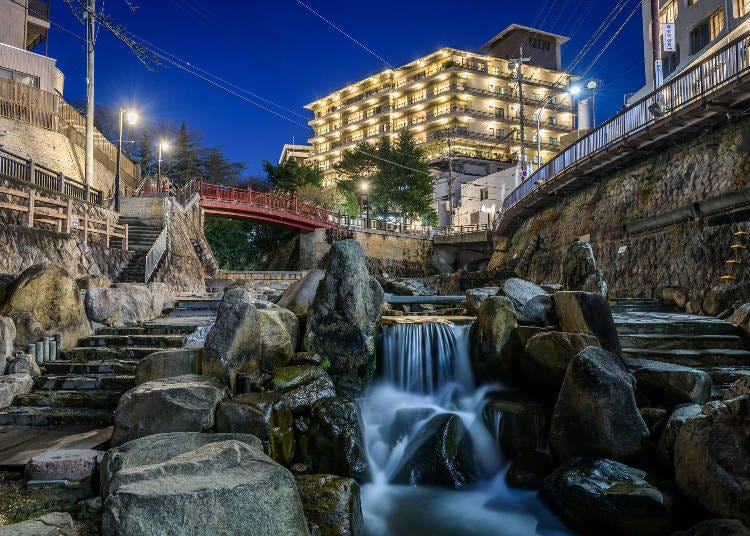
Arima Onsen (有馬温泉) is one of Japan’s three oldest hot springs, said to have been frequented by Toyotomi Hideyoshi. It has long been known as the ‘inner parlor of the Kansai Region.’
The hot spring town extends out at the foot of the Momiji Valley, located on the north side of the Rokko Mountains in Hyogo Prefecture. Easily accessible from central Kobe City, it’s a beautiful spot surrounded by mountains and nature, with a retro townscape of old-fashioned hot spring inns and souvenir shops.
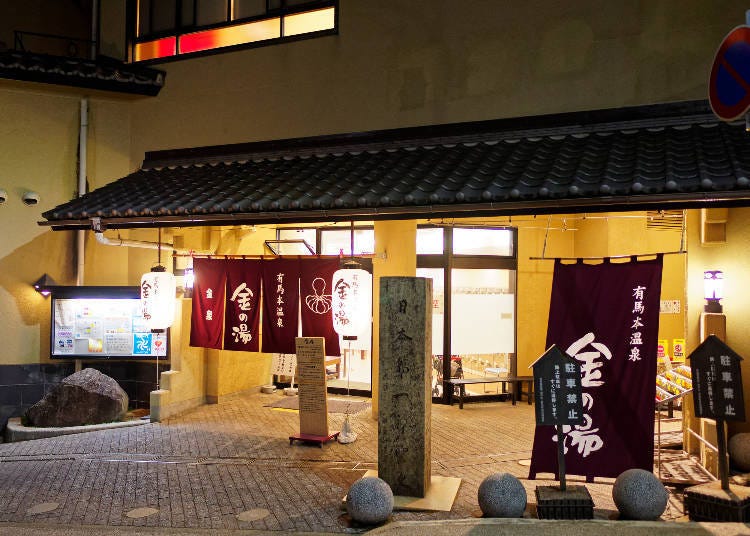
There are two types of hot springs: the tan-colored Kinsen, and the transparent Ginsen. After your soak, you may also want to check out the steaming springs!
- Tips on visiting:
- These springs boast a long history and tradition, despite its proximity to the city. It’s a nostalgic townscape, with lots of historical sites and shops that sell traditional crafts.
- About the hot springs:
- There are about 30 hot spring accommodations in the area, including those that offer day-trip bathing.
- Hot spring qualities & benefits:
- These springs contain seven of the nine main components needed to designate it as a therapeutic spring by the Ministry of the Environment (simple thermals, carbon dioxide, bicarbonate, chloride, sulfate, iron, and sulfur spring). The Kinsen springs have been around since ancient times in Arima Onsen, and contain iron and salts. The Ginsen springs contain carbonic acid, and are said to be beneficial for hypertension and appetite stimulation.
- Getting there:
- From Hanshin/Hankyu Osaka Umeda Station, ride Shinkaichi Line to Kobe Electric Railway Arima Onsen Station. (Approx. 1 hr 30 min)
Alternatively, take bus bound for Arima Onsen from Sannomiya Station Terminal (approx. 30 min)
-

-
Address
987 Arimacho, Kita-ku, Kobe-shi, Hyogo, 651-1401
View Map -
Nearest Station
Arimaonsen Station (Kobe Dentetsu-arima Line)
10 minutes on foot
-
Address
987 Arimacho, Kita-ku, Kobe-shi, Hyogo, 651-1401
7. Yumura Hot Spring (Hyogo Prefecture)
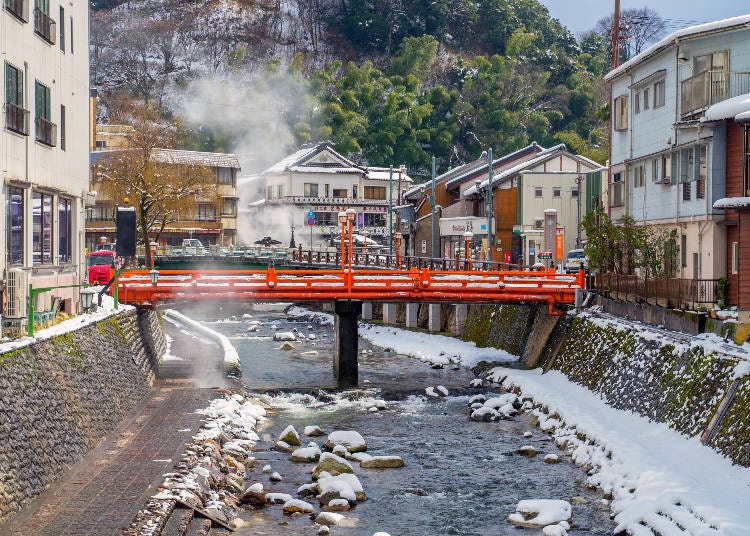
Yumura Onsen (湯村温泉) is located in northwestern Hyogo Prefecture along the Sea of Japan. It is said to have been discovered about 1,200 years ago by Buddhist priest, Jikaku Daishi.
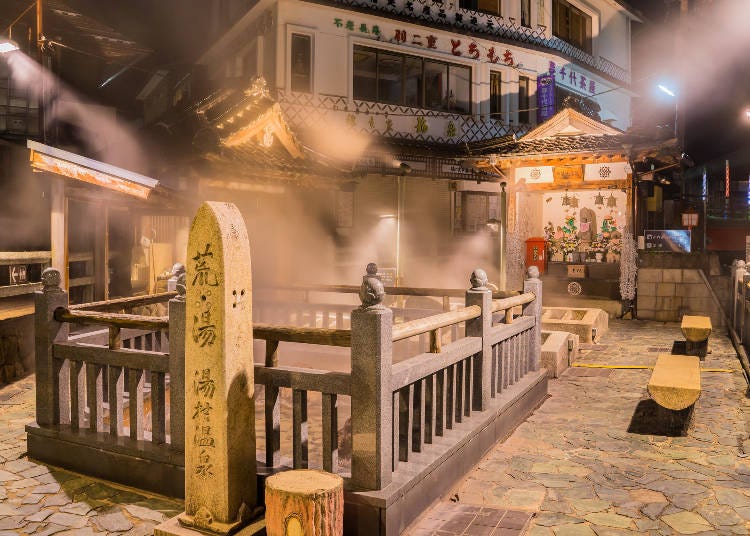
The hot spring, originally called Arayu, is a high-temperature spring at 98 degrees Celsius. You’ll also see tourists boiling eggs in these springs, a unique tradition of Yumura Onsen.
Boasting an abundance of hot water, the springs are also distributed to each household. You can enjoy a relaxing, natural, free-flowing footbath along the Haruki River, or soak in the springs at nearby facilities, such as Refresh Park Yumura (a ‘hot springs park’ that sources its waters from Yumura Onsen) and Yakushiyu (located near Arayu, the source of Yumura Onsen).
- Tips on visiting:
- Motoyu (Arayu) is a hot spring with a temperature of 98 degrees Celsius, gushing 470 liters per minute. The hot spring area is rich in nature, with a gorgeous snowy landscape in the winter.
- About the hot springs:
- There are about 20 hot spring inns along the Haruki River, with lots of souvenir shops around Arayu.
- Hot spring qualities & benefits:
- This weakly alkaline, high-temperature hot spring has a pH of 7.29 and contains sodium-bicarbonate, chloride, and sulfate. The drinking water drawn from these springs is said to be beneficial for chronic digestive diseases and gout.
- Popular places to stay:
- Kasenkyo Izutsuya, Asanoya, Yumura Onsen Tomiya
8. Shirahama Onsen (Wakayama Prefecture)
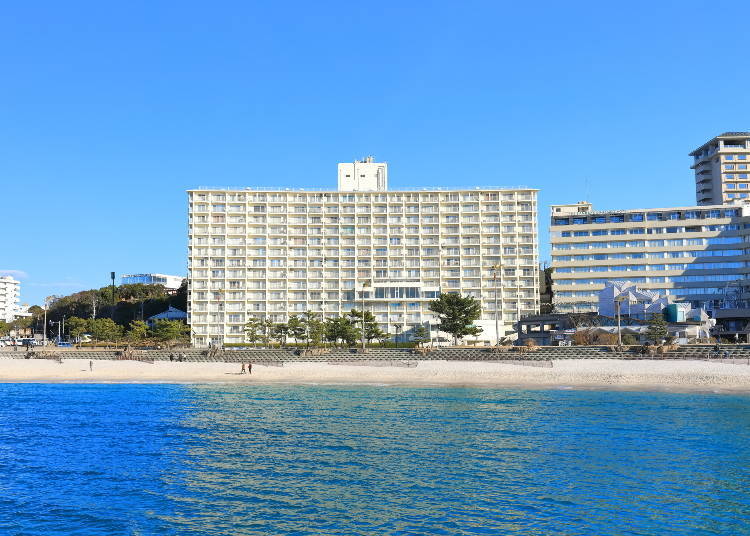
Shirahama Onsen (白浜温泉) is one of Japan’s three oldest hot springs, together with Arima Onsen. This spring has a long history, and is even mentioned in Japan’s oldest historical writings, the Manyoshu and Nihonshoki. Overlooking the sea, many of the accommodations here also offer stunning ocean views and a variety of hot spring baths.
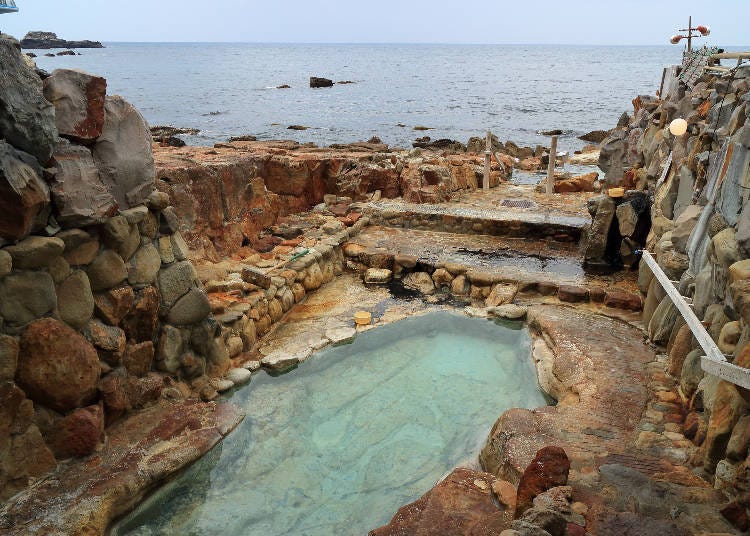
Saki-no-Yu is an open-air bath, surrounded by waves crashing against the rocks. It’s also the only surviving of the historic Yuzaki Nanayu (the ‘Seven Hot Springs of Yuzaki’). Enjoy a foot bath, or take an open-air bath tour. Check out Muro-no-Yu, which sources its waters from two types of springs, and Shirarayu, a sento-like public bath adjacent to Shirarahama Beach.
There are also plenty of sightseeing attractions and recreational facilities, including the nearby Adventure World, and scenic spots like Engetsuto, Sandanbeki, and Senjojiki.
- Tips on visiting:
- In addition to elaborate hot springs, there are a number of tourist attractions in the surrounding area, including the white, sandy beaches of Shirara-hama, Shirahama’s landmark Engetsujima, and Senjojiki, a natural landscape formed by the rough waves.
- About the hot springs:
- There are about 20 hot spring inns and hotels in the area. Nanki Shirahama Airport is located right near the town.
- Hot spring qualities & benefits:
- There’s a variety spring sources of different qualities, including chloride springs, sulfur springs, bicarbonate springs, and simple springs. Chloride springs are said to offer moisturizing benefits, while bicarbonate springs are said to have a smoothing effect on the skin.
- Getting there:
- From JR Shin-Osaka Station, take Limited Express Kuroshio to Shirahama Station (approx. 2 hr 30 min)
-

-
Address
868, Shirahama, Wakayama, 649-2211
View Map -
Nearest Station
Shirahama Station (JR Kisei Line / JR Kinokuni Line)
Vacancy search, reservation
-
from 11,900JPY 1room, 2adults
Check with our partner site as the latest rates, rate details, and guest room requirements may vary.
-
Address
868, Shirahama, Wakayama, 649-2211
-

-
Address
2500-185, Katata, Shirahama-cho, Nishimuro-gun, Wakayama, 649-2201
View Map -
Nearest Station
Shirahama Station (JR Kisei Line / JR Kinokuni Line)
10 minutes by bus
- Phone Number 0739-82-2391
-
Address
2500-185, Katata, Shirahama-cho, Nishimuro-gun, Wakayama, 649-2201
9. Nanki Katsuura Onsen (Wakayama Prefecture)
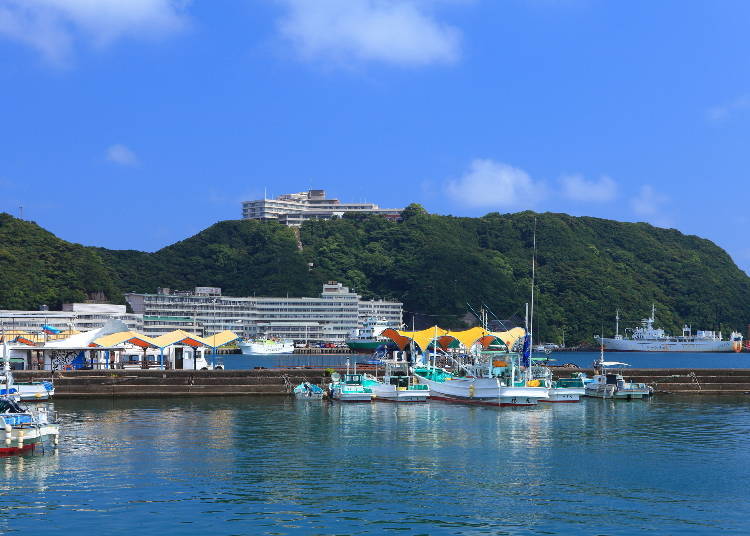
Located at the southern tip of the Kii Peninsula in Wakayama Prefecture, Nanki Katsuura Onsen (南紀勝浦温泉) is one of Wakayama’s signature hot spring resorts, along with Shirahama Onsen.
The nearby Katsuura Port boasts the largest catch of fresh tuna in all of Japan, with a strong fishing industry that’s flourished since ancient times. Kinomatsushima also adds to this gorgeous scenery, consisting of many islands, large and small, around Katsuura Port.

There are a number of hot spring sources, with many accommodation facilities boasting their own spring sources. Go for a swim at Blue Beach Nachi (Nachi Beach), designated as one of Japan’s top 100 swimming beaches by the Ministry of the Environment, take a pleasure boat tour of Kinomatsushima, or watch a live fish auction at the Katsuura Fishing Port!
- Tips on visiting:
- A hot spring with many sources and an abundance of hot water. There are also several famous cave baths formed from rough waves and rocky surfaces, including Hotel Urashima’s Bokido and Genbudo.
- About the hot springs:
- The area has fewer than 10 hot spring accommodations, however, there’s a number of famous attractions to see, including some World Heritage sites!
- Hot spring qualities & benefits:
- There are sulfur springs, chloride springs, simple hot springs, and more. Health benefits include alleviating cold sensitivity, neuralgia, muscle pain, and fatigue.
- Getting there:
- From JR Shin-Osaka Station, take Limited Express Kuroshio to Kii-Katsuura Station (Approx. 3 hr 40 min)
-

-
Address
216-19 Katsuura, Nachikatsuura-cho, Higashimuro-gun, Wakayama Prefecture, 649-5334
View Map -
Nearest Station
Kiikatsura Station (JR Kisei Line / JR Kinokuni Line)
10 minutes on foot
- Phone Number 0735-52-0333
-
Address
216-19 Katsuura, Nachikatsuura-cho, Higashimuro-gun, Wakayama Prefecture, 649-5334
-

-
Address
1530, Tenma, Nachikatsuura-cho, Higashimuro-gun, Wakayama, 649-5331
View Map -
Nearest Station
Kiitemma Station (JR Kisei Line / JR Kinokuni Line)
7 minutes on foot
- Phone Number 0735-52-0750
-
Address
1530, Tenma, Nachikatsuura-cho, Higashimuro-gun, Wakayama, 649-5331
10. Ryujin Onsen (Wakayama Prefecture)

Ryujin Onsen (龍神温泉) is situated along the Hidaka River in Koya Ryujin Quasi-National Park, which straddles Wakayama and Nara prefectures. It is known as one of Japan’s three most beautiful hot springs and is famous for its sodium-bicarbonate springs, which are said to offer smoothing and moisturizing benefits for the skin.
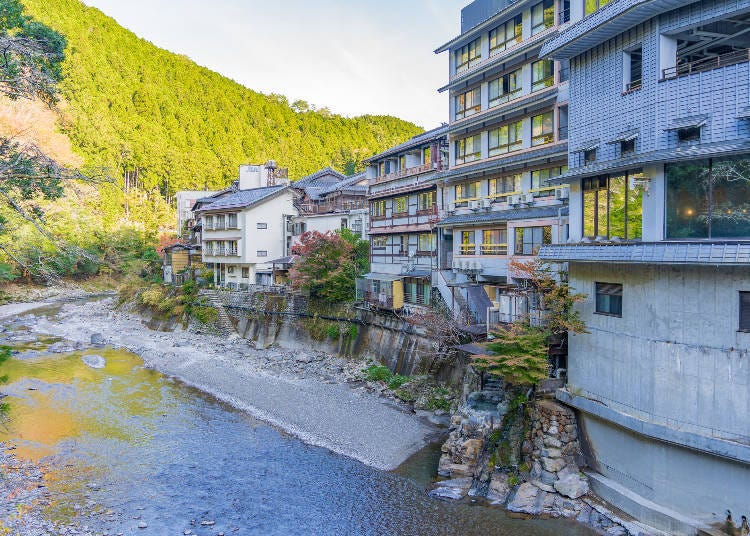
Here you’ll find a mixture of hot spring inns for travelers as well as a couple of day-trip bathing facilities. There’s also a communal bath called Motoyu, which is equipped with cypress baths, rock baths, and open-air baths that overlook the mountain stream. Nyu Yamasemi Onsenkan is another open-air bath that was built from an old school building. With such a variety of springs available, you’re free to enjoy a nice, relaxing soak at your leisure.
- Tips on visiting:
- The spring quality is sodium-bicarbonate. It is popular for its beautifying and moisturizing effects on the skin, and is also great for keeping your body warm.
- About the hot springs:
- There are about 15 inns and guesthouses in the secluded area surrounded by nature.
- Hot spring qualities & benefits:
- These sodium-bicarbonate springs are said to be beneficial for chronic skin diseases, neuralgia, muscle and joint pain, and more. When consumed as drinking water, it is also said to help alleviate chronic digestive diseases, diabetes, and gout.
- Getting there:
- From Kii-Tanabe Station Kinokuni Line, take bus to Ryujin Onsen Bus Stop (Approx. 1 hr 30 min)
Kansai is home to so many wonderful hot spring resorts, we couldn’t possibly introduce them all here! Each spring has its own history, surrounded by amazing attractions, delicious food, and beautiful scenery. So head to Kansai for some sightseeing, and unwind with a soothing soak in a local hot springs inn. With so many fabulous facilities, your most difficult task will be picking a favorite!
English translation by: Krys Suzuki
*Information in article as of November 2022. Please see official websites for the latest updates and information.
Kiko Matsuda, Keiko Kimura, Risa Tsushi, and a team of female writers familiar with Kansai. We love eating, drinking and traveling! We share fun information based on our experiences.
*Prices and options mentioned are subject to change.
*Unless stated otherwise, all prices include tax.
Popular Tours & Activitiess
Recommended places for you
-

ISHIDAYA Hanare
Yakiniku
Kobe, Sannomiya, Kitano
-

Kambei Sannomiyahonten
Yakiniku
Kobe, Sannomiya, Kitano
-

Jukuseiniku-to Namamottsuarera Nikubaru Italian Nikutaria Sannomiya
Izakaya
Kobe, Sannomiya, Kitano
-
Events

KYOTO TAKENOSATO ONSEN MANYO NO YU
Hot Springs (Onsen) & Bath Houses (Sento)
Kyoto Station, To-ji Temple
-
Goods

Yoshida Gennojo-Roho Kyoto Buddhist Altars
Gift Shops
Nijo Castle, Kyoto Imperial Palace
-

Kanzenkoshitsuyakinikutabehodai Gyugyu Paradise Sannomiya
Yakiniku
Kobe, Sannomiya, Kitano
-

Celebrate a Dreamy Barbapapa Christmas at JR Osaka Station's Twilight
by: Guest Contributor
-
Ad

Café Bahnhof in Osaka: The home-roasted coffee that captivated G20 leaders!
-

New Way to Reach Koyasan! Ride Nankai's 'GRAN Tenku' for a Heavenly Journey
by: Guest Contributor
-

Everything You Need to Know About teamLab Biovortex Kyoto (2025 Insider Guide)
by: Wemmy Chau
-

Best Things to Do and See Around Kyoto & Osaka in September: Events and Festivals in Kansai
-
Ad

Experiencing Manga as Culture, Not Just Reading It: Expo 2025 with Rumiko Takahashi
Inspiration for Accommodations
-

Spacious Family Hotel in Namba: 20 Comfortable Stays for Family Fun
-

Charming Hotels to Enjoy the Spectacular Views of Arashiyama's Autumn Leaves from Your Room
-

Experience Stunning Views of Osaka Castle from Private Spaces: Top Hotels Near Osaka Castle
-

Recommended by Visitors! Arashiyama's Best-Rated Hotels
-

Family-Friendly Universal Studios Japan Hotel with Excellent Access
-

Enjoy a Comfortable Stay in Osaka! 10 Hotels with Convenient Airport Shuttle Services
-

Top 10 Recommended Hotels Near Namba Station with Great Access
-

Enjoy Night Views from Your Room! Recommended Hotels in Namba Area
-

Osaka's Solaniwa Onsen Theme Park Takes Bathing To The Next Level
by: WESTPLAN
-

Osaka Spa World: Inside The Insane Onsen Complex!
-

8 Recommended Hot Spring Hotels and Onsen in Osaka
by: Cassandra Lord
-

What to Pack for Japan: 8 Essential Things for a Hassle-Free Trip
-

5 Popular Shops and Gift Ideas Along Arashiyama Shopping Street
-

6 Surprisingly Cheap Things in Japan
- #best gourmet Osaka
- #things to do Osaka
- #what to do in kyoto
- #what to bring to japan
- #best gourmet Kyoto
- #new years in Osaka
- #what to buy in nanba
- #Visiting Osaka
- #onsen tattoo friendly arima
- #daiso
- #Visiting Kyoto
- #best japanese soft drinks
- #japanese fashion culture
- #japanese convenience store snacks
- #japanese nail trends













